For New Bedford, Massachusetts homeowners looking to enhance their outdoor spaces, installing a new fence offers both privacy and property value. However, ensuring compliance with local regulations and selecting the perfect fence type is crucial. This article guides you through the process, from navigating New Bedford’s fencing laws to building a durable barrier. We’ll cover everything from choosing materials and measuring your yard to step-by-step installation instructions, ensuring your DIY fence project is both successful and long-lasting.
- Understanding New Bedford's Fencing Regulations
- Choosing the Right Fence for Your Yard
- Measuring and Planning Your Fence Layout
- Tools and Materials Needed for Installation
- Step-by-Step Guide to DIY Fence Building
- Tips for a Strong and Long-Lasting Fence
Understanding New Bedford's Fencing Regulations
Before beginning your DIY fence installation project in New Bedford, it’s crucial to familiarize yourself with local regulations. Different towns and cities have unique zoning laws and building codes that dictate aspects such as fence height, materials, placement, and distance from property lines. Failure to adhere to these regulations can result in fines or even the requirement to remove the fence.
New Bedford’s guidelines are designed to maintain neighborhood aesthetics, ensure safety, and promote uniform development. Homeowners should consult the local building department or check online resources for detailed information on fencing regulations. Understanding and complying with these rules will ensure your project goes smoothly and you avoid any potential legal issues down the line.
Choosing the Right Fence for Your Yard
When selecting a fence for your New Bedford yard, consider the style that best complements your home’s architecture and surrounding landscape. Fences come in various materials like wood, vinyl, or metal, each with unique aesthetics and maintenance requirements. Wood offers a classic, natural look but demands regular treatment to resist rot and insects. Vinyl is low-maintenance and available in numerous colors and styles, while metal fences provide durability and a modern aesthetic but may require more frequent cleaning.
Take into account the purpose of your fence as well. Is it for privacy, security, or purely ornamental reasons? Different fence types offer varying levels of seclusion. Tall, solid fences provide maximum privacy, whereas picket fences or open-lattice designs allow for better visibility while still defining your property lines.
Measuring and Planning Your Fence Layout
Before you begin installing your DIY fence, careful planning is essential. Start by measuring the perimeter of the area where you want to place your fence. Use a tape measure to ensure accurate measurements, and mark out the boundary with stakes and string for a clear visual reference. Consider factors like existing structures, trees, or utility lines that might impact your layout.
Create a detailed plan by sketching out your desired fence layout on paper. Decide on the style of fence (e.g., picket, privacy, or chain-link), its height, and the number of posts required. Ensure your design aligns with local building codes and regulations to avoid any legal issues. A well-thought-out plan will make the installation process smoother and more efficient for New Bedford homeowners taking on this project themselves.
Tools and Materials Needed for Installation
To tackle your DIY fence installation project successfully, there are several essential tools and materials you’ll need to gather before beginning. For most standard wooden fence installations in New Bedford, Massachusetts, you’ll require a mix of hand tools (like hammers, saws, and screwdrivers) and power tools (a drill or driver, often with a set of various bit sizes). Don’t forget safety gear like work gloves, eye protection, and earplugs. For the fence itself, plan on purchasing high-quality wooden posts, rails, and pickets suitable for your desired height and style, along with adequate concrete for setting the posts. You may also need hardware such as brackets, fasteners, and post caps to complete the assembly and provide a secure finish.
Step-by-Step Guide to DIY Fence Building
Building a fence can be a rewarding DIY project, offering both aesthetic enhancement and practical benefits for your New Bedford property. Here’s a step-by-step guide to ensure success: Start by measuring the perimeter of the area where you want the fence. This will help you determine the exact length of materials needed. Next, choose the type of fence that best suits your needs—wooden posts, chain link, or vinyl, for example—and procure the necessary tools and supplies, including post holes diggers, hammers, string lines, and the appropriate fencing material.
Once all materials are gathered, begin by marking out the fence line with a string line for precision. Dig the post holes, ensuring they’re deep enough to support the fence posts securely. Set the posts in place, ensuring they’re level and aligned. Fill the holes with concrete, allowing it to dry completely before attaching the fencing material. Continue installing vertical supports at regular intervals according to your design, then add horizontal rails for a sturdy framework. Finally, attach the chosen fencing material, whether panels, pickets, or chain link fabric, securing it tightly for a durable finish.
Tips for a Strong and Long-Lasting Fence
To ensure your fence stands strong against New Bedford’s varying weather conditions, start by choosing high-quality materials suited for outdoor use. Treated wood and durable vinyl are popular choices known for their resistance to rot, decay, and extreme temperatures. Proper preparation is key; treat wooden posts with preservative before installation, and ensure a level surface for each post to prevent uneven settling. Regular cleaning and sealing will also extend the life of your fence.
Consider the layout and design early on, keeping in mind factors like privacy needs, local regulations, and aesthetic preferences. A well-planned fence design not only enhances your property’s curb appeal but also offers better structural integrity. After installation, maintain regular inspections to check for loose connections or signs of damage, addressing issues promptly to keep your fence strong and secure for years to come.
